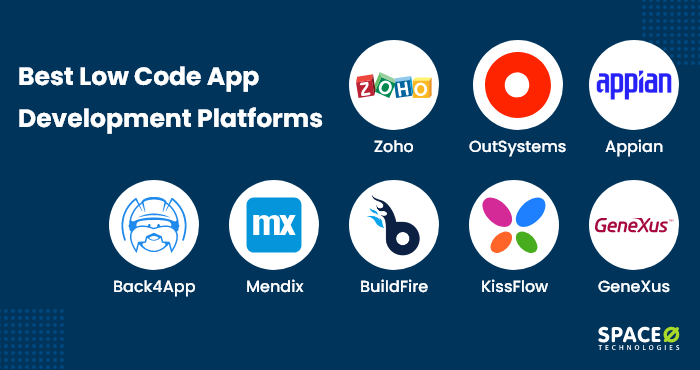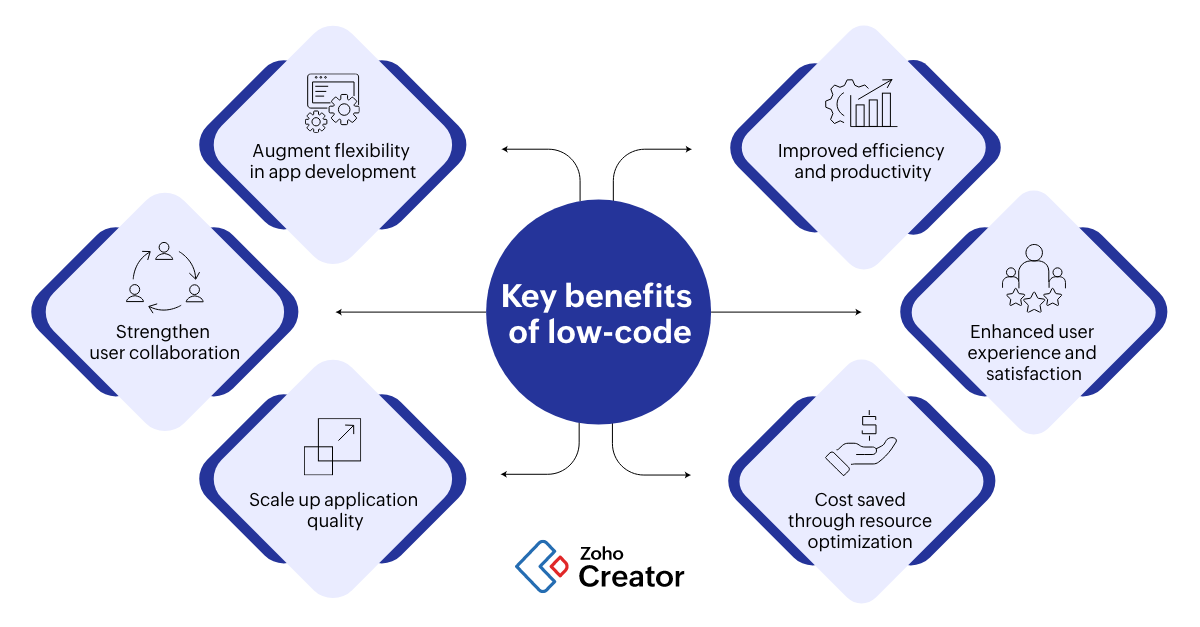Visual Development Environment :
Drag-and-Drop Interfaces: Low-code platforms provide visual tools for designing applications. Developers can utilize drag-and-drop tools to quickly assemble applications without having to write a lot of code.
Pre-built Templates and Components A number of low-code platforms include templates and components that are pre-built, that allow developers to quickly create and prototype applications without the need to begin from the beginning.
Reduction of Coding Requirements
Automated code generation: Low-code platforms generate the code base on the visual models developed and maintained by the developers. This eliminates the requirement to code manually and speeds up the development process.
Reusable Components: Developers are able to use reusable components across different projects, minimizing the time they spend writing and testing code.
Collaboration is made easier:
Low-code development platforms are often equipped with tools like deployment control, version control and testing. This allows seamless collaboration across teams.
Citizen development: Through the use of intuitive interfaces and reducing bottlenecks that are often caused by insufficient availability of developers, business users as well as non-developers can help in the development of applications.
Rapid prototyping and rapid iteration:
Fast Prototyping : Developers create prototypes in a short time to validate ideas and gather feedback. This can result in a less time spent on iterations.
Easy Modifications: Low-code development is oriented towards visuals, which makes it easier to change and update applications. It also speeds up the process for refining and optimizing applications in response to feedback from users.
Pre-built Integrations:
API Integrations Low-code platforms include built-in connectors that work with APIs or services that are popular. They reduce the time it takes to integrate external applications.
Data Integration: Built-in tools for data-integration make it easier to connect databases and other data sources. This accelerates development.
Deployment and Scaling
Many low-code platforms have the option of deploying applications with one click, which reduces the time and effort required to install applications.
Cloud-Based Solutions: Cloud-based, low-code platforms are able to handle scaling and infrastructure management and allow developers to focus on application logic and functionality instead of deployment logistics.
The primary benefit of low-code application development with regard to speed, is its capacity to automatize and simplify many aspects in the development process. This enables rapid delivery of software and quicker adaptations to changing demands. View the top Low-code Platform for application development for more tips including develop cross platform mobile app, mobile development platforms, azure sql, application modernization software, develop web application, app platforms, build with docker, azure sql databases, lowcode no code, lowcode no code and more.

Low-Code Applications Are Cost-Effective.
Low-code application development has numerous advantages, such as cost-effectiveness. It is a popular alternative for companies looking to reduce development costs without compromising on quality. Here are the major benefits:
Lower Coding Requirement: Lower coding platforms eliminate the need to write code manually, saving developers both time as well as money. This translates into less labor costs.
Less developers: Since low code development is faster and more simple, there are fewer specialized developer resources required. This reduces the need for costs of recruiting and retaining personnel.
Faster time to market:
Accelerated Development Cycle: Visual tools that are low-code and components allow for rapid development of applications, which lets businesses launch their products faster. This could result in faster revenue growth and better standing in the market.
Rapid prototyping. By quickly creating and testing prototypes, companies can reduce time spent on development and iterate faster based on feedback from users.
Lower Maintenance Costs
The modular architecture and standardized components of applications developed with low-code platforms make them easier to maintain. This reduces the ongoing maintenance and support costs.
Automated updates: A lot of low code platforms automatically handle updates and patches, making sure that the applications are safe and current with no need for manual intervention.
Efficient Resource Utilization:
Contributions by non-developers: Low-code platforms empower non-developers, such as business users, to participate in the development process. This democratization of development processes enables businesses to utilize the skills and abilities of a broader range of employees.
Utilizing IT resources efficiently IT teams can focus on strategic initiatives rather than getting bogged down with mundane work on development, thereby increasing efficiency and productivity overall.
Price models that can be scaled:
Subscription-Based Price: Many low-code platforms provide flexible subscription-based pricing that scales according to use. This lets businesses be able to align their spending with the actual demands and growth while avoiding significant up-front costs.
Pay-Asss-You-Go Option: Some platforms offer pay-as-you-go options that guarantee businesses only pay when they make use of resources. This is particularly beneficial for small and start-up businesses with limited budgets.
Lowering Third-Party Costs of Software:
Built-in Functionalities: Low-code platforms have a variety of built-in functions and integrations, which eliminate the need for third-party software and tools. License and subscription fees are also reduced.
Pre-Built Integrations: The accessibility and pre-built integrations for popular services and system minimizes the need for custom development and can save time and money.
Improved ROI
Faster ROI: Businesses can gain a greater ROI on their apps by combining speedy development, less expensive and a faster times to market.
Improved Agility: Businesses can quickly adapt to changes in the market and customer needs, ensuring that they stay relevant and can capitalize on new opportunities as they arise.
Reduced Training Costs
User-friendly interfaces: Low-code platforms provide user-friendly and easy interfaces that cut down on the learning curve. They also minimize the requirement for long-running courses of instruction.
Accessible Resources that are accessible. Many low-code platforms provide complete training materials and tutorials as well as community support. They eliminate the need to undergo formal training, which can be costly.
A more efficient collaboration
Enhanced collaboration Tools: The integration of collaboration tools enables better communication between team members as well as an improvement in overhead for projects.
Unified Development Environment: A single, unified development environment helps streamline workflows and reduces the cost and complexity of managing multiple platforms and tools.
The value of low-code development comes from its ability lower maintenance and development costs, accelerate the time to market, improve resources, and also offer flexible pricing models. Low-code provides significant financial benefits for companies. Take a look at the most popular over here about Enterprise application development with Low-code Platform for website advice including multiplatform mobile app development, microsoft azure sql, cross platform mobile app development, sso azure, develop mobile application, mobile app development platforms, rapid applications, microsoft azure sql, developing mobile apps, cloud software applications and more.

Benefits Of Low-Code Application Development In Workflow And Collaboration
The low-code approach to development of applications offers a variety of advantages in terms of workflow and collaboration and collaboration, making it a fantastic choice for companies seeking to boost team productivity and speed up their process of development. These are the major benefits.
Unified Development Environment : Low-code platforms provide a unified, one-stop environment where all team members are able to work effectively including designers, business analysts, and other stakeholders. They eliminate silos and encourage better communication.
Visual Development Tools: Low-code platforms are easy to use and feature a drag-and drop interface. This allows non-technical members of the team to be involved in the process of development and ensures that the business requirements can be gathered precisely.
Improved Communication:
Real-Time Collaboration Many low-code applications have real-time features such as editing and commenting simultaneously, or immediate feedback. This enables continuous communication, and helps reduce the amount of time wasted on back-and-forth discussions.
Shared Workspaces Teams can work together using shared workspaces. They can use these workspaces to review, edit and collaborate on project components.
A streamlined workflow management system:
Integrated Project Management Tools: A lot of low-code platforms come with integrated tools for managing projects which can assist teams to track and organize their development projects. This includes task assignment, progress tracking, and deadline management.
Workflow Automation Automating repetitive tasks as well as workflows can reduce manual mistakes and work and allow the team to concentrate on more strategic work while increasing efficiency.
Speedier Iteration Cycles:
Rapid prototyping: Low-code platforms permit rapid prototyping rapid development, iterative development, and prototyping, which allows teams to create applications to test and improve the applications in shorter time. This means feedback can be integrated quickly and improvements can be made.
Agile Development Support: Supporting agile methodology allows teams and individuals to work in smaller increments. It can also allow you to quickly adapt to changes.
Accessibility for Non-Developers:
Citizen Development: Low-code platforms give business users the ability to develop and modify applications without coding expertise. This relieves IT and Development teams of burdens and gives them the ability to respond faster to business requirements.
Onboarding and Training. The user-friendly interfaces of the tools for training make it easy for the new members to become familiar with the system, and this improves the teamwork.
Centralized Documentation and Knowledge Sharing
Integrated documentation Low-code features typically allow you to create and manage documents on the platform. All project information is centrally accessible and easy to access.
Knowledge Repositories Teams can build and maintain repositories for knowledge that include best practice, templates, and reuseable elements, helping in the sharing of information and reducing the amount of duplicate information.
Consistency, Standardization and Standards:
Standardized Components: The use of pre-built, standard components guarantees consistency across applications, making it easier for team members to understand and collaborate on various aspects of the project.
Compliance and governance Frameworks built-in for governance ensure that applications are designed in accordance to organizational standards, regulatory requirements, and quality standards. They minimize the chance of not being compliant and ensure that applications meet specifications.
Feedback loops:
Integrated Feedback Low-code platforms offer users with feedback mechanisms integrated into them that allow them to provide feedback easily on applications. This feedback can be used in the development process.
Continuous Improvement: The ability of rapidly implementing changes based on feedback will ensure that applications are constantly developed, while being in tune with the needs and objectives of users.
Visualization and Reporting:
Real-time analytics: Built-in analytical and reporting tools provide real-time information about the progress of projects, their performance, and user interactions. They facilitate the use of data to make informed decisions.
Visual Workflow Analysis Visual tools are used to map processes and workflows. These tools aid teams to identify and improve their workflows.
When it comes to collaboration, low-code apps are an excellent way to simplify workflows, bring diverse teams together and streamline tasks. This promotes a more agile, collaborative and efficient environment for development, which ultimately results in better-quality applications and better alignment with business objectives.
